For sellers: The points and usage of Banban Board

- ランキングの上位にない商品も、幅広く購入の候補にしてもらえる
- カードに自動で画像、価格、説明を入力し、販売のチャンスを増やす
- 売上アップにつながるのは複数の画像と十分な商品説明
- バンバンボードに自社の商品を入れてもらう2の方法
- 技術資料: バンバンボードに入る商品説明・価格データの記載方法
- APIで構造化データを提供する
How to get purchasers consider about your products that are not in the top rankings
When shopping online, finding the one that suits you among the myriad of products and companies is a daunting task. People tend to rely on the rankings of reviews and price, so orders go to companies with high rankings.
Sellers can't sell just by arranging their products. Every seller knows impotance of improving the products and dialogues with customers, but in reality, in order to push the company's products to the top of the ranking, Spending money and effort on things that have nothing to do with, such as SEO, blogs, and social medias.

The Bang Bang Board is a tool for purchasers to compare and consider the products of various online shops as Bang Bang and Cards.
Since you can rearrange the cards on the board and organize them in an easy-to-understand manner according to whether or not they suit your purpose, products that are not in the top rankings can also be widely considered.

For sellers, there will be more opportunities for their products to be candidates beyond their own online shops and shopping malls.
The Bang Bang board is a powerful sales channel that increases sales opportunities even if you are not ranked high. In addition, it will be an opportunity to redirect the costs that have been spent on SEO to improve the value of the original product and dialogue with customers.
To increase sales chances, fill a card with images, a price ,and a description automatically.
On many online shopping sites, cards are filled automatically. In most cases, you don't need to do anything.
Requestland reads the “structured data” of product pages on the online shopping sites. If your product data does not appear on a card, show below to a tech person.
Include structured data on your product page on your website so that cards on Banban Boards will automatically be filled with images, a price, and a description.
- Requestland supports Microdata and JSON-LD. Both can exist on a page. Microdata has priority over JSON-LD.
- Provide name, image, and description of Product and price and priceCurrency of Offer in either Microdata or JSON-LD.
- The image gallary on the card can be filled with some methods.
- Put some images in ImageGallery of Microdata
<meta itemprop="imagegallary" content="[\"https://example.com/image0.jpg\", \"https://example.com/image1.jpg\"]"/>
- Put one or some images in Image of Microdata
<meta itemprop="image" content="[\"https://example.com/image0.jpg\", \"https://example.com/image1.jpg\"]"/>
- Put an image in image of JSON-LD
- Put a list of images in image of JSON-LD
- Put some images in ImageGallery of Microdata
- To show rich text and images on Description, add the following (Microdata Description) to the enclosing <div> of the product description on the product page. JSON-LD's description cannot include rich text and will have some new-lines.
<div itemtype="https://schema.org/Product">
<div itemprop="description">Your HTML code for product description</div>
</div>A very large description is not welcome, since our server is small.
Since it lacks CSS and JavaScript, it will not be formatted as well as the original page. Some HTML tags and attributes including <script> will be removed.
- og:site_name or the domain name is used as a site name.
Example: Microdata
<div itemtype="https://schema.org/Product">
<meta itemprop="image" content="[\"https://example.com/image0.jpg\", \"https://example.com/image1.jpg\"]"/>
<div itemprop="description">Description(HTML)</div>
<div itemprop="offers" itemtype="https://schema.org/Offer">
<div itemprop="offers" itemtype="http://schema.org/Offer">
<meta itemprop="priceCurrency" content="USD"/>
<meta itemprop="price" content="44.99"/>
</div>
</div>
Provide an API to fill cards. (In preparation)
If your website is a progressive web app (PWA) or any other page that generates structured data on the client, please provide an API.
Register API key, endpoint, and regex for getting an item ID from a URL to Requestland from the options page.
Example
API response: Send structured data as Microdata or JSON-LD
When submitting Microdata, send a string of HTML. The top elements must be one or more divs and each div includes itemscope and itemtype.
e.g.
When sending JSON-LD, send an array or an array of arrays.
e.g.
or
[[{"@context": "https://schema.org/", "@type": "Product","sku": "112639037","image": "https://image.example.com/image0.jpg", "name": "Your product name","description": "Your product description..."}...], [...]]